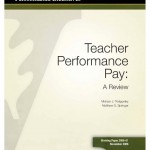Teacher Performance Pay: A Review
In this paper we examine the research literature on teacher performance pay. Evidence clearly suggests an upsurge of interest in many states and school districts; however, expanded use of performancy pay has been controversial. We briefly review the history of teacher pay policy in the U.S. and earlier cycles of interest in merit or performance-based pay. We review various critiques of its use in K-12 education and several strands of empirical research that are useful in considering its likely impact. The direct evaluation literature on incentive plans is slender, focused on short-run motivational effects, and highly diverse in terms of methodology, targeted populations, and programs evaluated. Nonetheless, it is fairly consistent in finding positive program effects, although it is not at present sufficiently robust to prescribe how systems should be designed – for example, optimal size of bonuses, mix of individual versus group incentives. It is sufficiently promising to support more extensive field trials and policy experiments in combination with careful follow-up evaluations. Since a growing body of research finds substantial variation in teacher effectiveness as measured by student achievement gains, future evaluations need to pay particular attention to the effect of these programs on the composition of the teaching workforce.
This paper was published in 2008 by the Journal of Policy Analysis and Management, 26(4): 551-573.
To view this paper, please click here.

Connect with Vanderbilt
©2025 Vanderbilt University ·
Site Development: University Web Communications